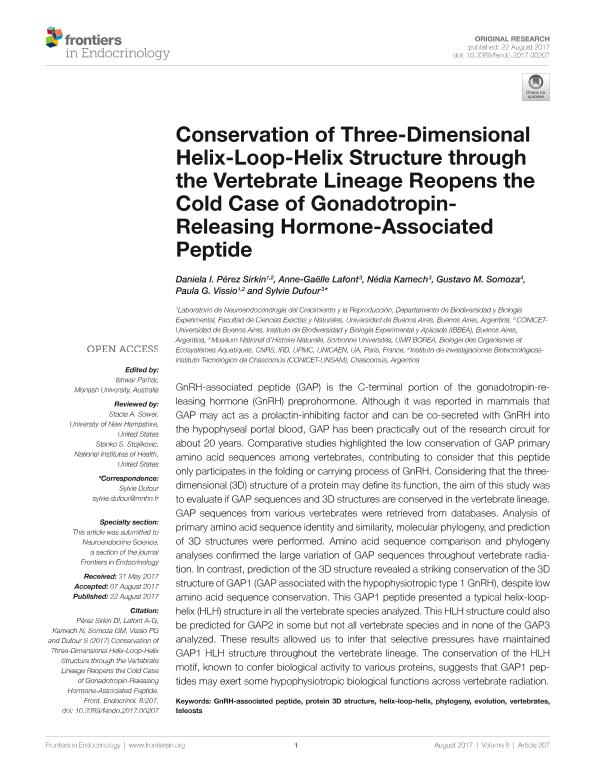Artículo
Conservation of three-dimensional helix-loop-helix structure through the vertebrate lineage reopens the cold case of gonadotropin-releasing hormone-associated Peptide
Pérez Sirkin, Daniela Irina ; Lafont, Anne Gaëlle; Kamech, Nédia; Somoza, Gustavo Manuel
; Lafont, Anne Gaëlle; Kamech, Nédia; Somoza, Gustavo Manuel ; Vissio, Paula Gabriela
; Vissio, Paula Gabriela ; Dufour, Sylvie
; Dufour, Sylvie
 ; Lafont, Anne Gaëlle; Kamech, Nédia; Somoza, Gustavo Manuel
; Lafont, Anne Gaëlle; Kamech, Nédia; Somoza, Gustavo Manuel ; Vissio, Paula Gabriela
; Vissio, Paula Gabriela ; Dufour, Sylvie
; Dufour, Sylvie
Fecha de publicación:
08/2017
Editorial:
Frontiers Research Foundation
Revista:
Frontiers in Endocrinology
ISSN:
1664-2392
Idioma:
Inglés
Tipo de recurso:
Artículo publicado
Clasificación temática:
Resumen
GnRH-associated peptide (GAP) is the C-terminal portion of the gonadotropin-releasing hormone (GnRH) preprohormone. Although it was reported in mammals that GAP may act as a prolactin-inhibiting factor and can be co-secreted with GnRH into the hypophyseal portal blood, GAP has been practically out of the research circuit for about 20 years. Comparative studies highlighted the low conservation of GAP primary amino acid sequences among vertebrates, contributing to consider that this peptide only participates in the folding or carrying process of GnRH. Considering that the three-dimensional (3D) structure of a protein may define its function, the aim of this study was to evaluate if GAP sequences and 3D structures are conserved in the vertebrate lineage. GAP sequences from various vertebrates were retrieved from databases. Analysis of primary amino acid sequence identity and similarity, molecular phylogeny, and prediction of 3D structures were performed. Amino acid sequence comparison and phylogeny analyses confirmed the large variation of GAP sequences throughout vertebrate radiation. In contrast, prediction of the 3D structure revealed a striking conservation of the 3D structure of GAP1 (GAP associated with the hypophysiotropic type 1 GnRH), despite low amino acid sequence conservation. This GAP1 peptide presented a typical helix-loop-helix (HLH) structure in all the vertebrate species analyzed. This HLH structure could also be predicted for GAP2 in some but not all vertebrate species and in none of the GAP3 analyzed. These results allowed us to infer that selective pressures have maintained GAP1 HLH structure throughout the vertebrate lineage. The conservation of the HLH motif, known to confer biological activity to various proteins, suggests that GAP1 peptides may exert some hypophysiotropic biological functions across vertebrate radiation.
Archivos asociados
Licencia
Identificadores
Colecciones
Articulos(CCT - LA PLATA)
Articulos de CTRO.CIENTIFICO TECNOL.CONICET - LA PLATA
Articulos de CTRO.CIENTIFICO TECNOL.CONICET - LA PLATA
Articulos(IBBEA)
Articulos de INSTITUTO DE BIODIVERSIDAD Y BIOLOGIA EXPERIMENTAL Y APLICADA
Articulos de INSTITUTO DE BIODIVERSIDAD Y BIOLOGIA EXPERIMENTAL Y APLICADA
Articulos(IIB-INTECH)
Articulos de INST.DE INVEST.BIOTECNOLOGICAS - INSTITUTO TECNOLOGICO CHASCOMUS
Articulos de INST.DE INVEST.BIOTECNOLOGICAS - INSTITUTO TECNOLOGICO CHASCOMUS
Citación
Pérez Sirkin, Daniela Irina; Lafont, Anne Gaëlle; Kamech, Nédia; Somoza, Gustavo Manuel; Vissio, Paula Gabriela; et al.; Conservation of three-dimensional helix-loop-helix structure through the vertebrate lineage reopens the cold case of gonadotropin-releasing hormone-associated Peptide; Frontiers Research Foundation; Frontiers in Endocrinology; 8; AUG; 8-2017; 1-12
Compartir
Altmétricas



